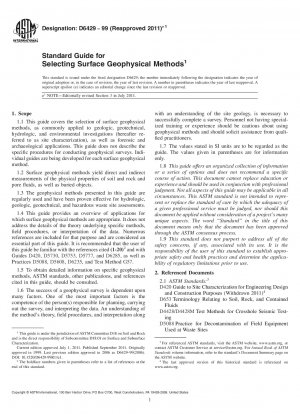ASTM D6429-99(2011)e1
Standard Guide for Selecting Surface Geophysical Methods
- Standard No.
- ASTM D6429-99(2011)e1
- Release Date
- 1999
- Published By
- American Society for Testing and Materials (ASTM)
- Status
- Replace By
- ASTM D6429-20
- Latest
- ASTM D6429-23
- Scope
This guide applies to commonly used surface geophysical methods for those applications listed in Table 1. The rating system used in Table 1 is based upon the ability of each method to produce results under average field conditions when compared to other methods applied to the same application. An “A” rating implies a preferred method and a “B” rating implies an alternate method. There may be a single method or multiple methods that can be applied with equal success. There may also be a method or methods that will be successful technically at a lower cost. The final selection must be made considering site specific conditions and project objectives; therefore, it is critical to have an experienced professional make the final decision as to the method(s) selected.
Benson (2) provides one of the earlier guides to the application of geophysics to environmental problems.
Ward (3) is a three-volume compendium that deals with geophysical methods applied to geotechnical and environmental problems.
Olhoeft (4) provides an expert system for helping select geophysical methods to be used at hazardous waste sites.
EPA (5) provides an excellent literature review of the theory and use of geophysical methods for use at contaminated sites.
An Introduction to Geophysical Measurements:
A primary factor affecting the accuracy of geotechnical or environmental site characterization efforts is the number of sample points or borings. Insufficient spatial sampling to adequately characterize the conditions at a site can result if the number of samples is too small. Interpolation between these sample points may be difficult and may lead to an inaccurate site characterization. Benson (2) provides an assessment of the probability of target detection using only borings.
Surface and borehole geophysical measurements generally can be made relatively quickly, are minimally intrusive, and enable interpolation between known points of control. Continuous data acquisition can be obtained with certain geophysical methods at speeds up to several km/h. In some cases, total site coverage is economically possible. Because of the greater sample density, the use of geophysical methods can be used to define background (ambient) conditions and detect anomalous conditions resulting in a more accurate site characterization than using borings alone.
Geophysical measurements provide a means of mapping lateral and vertical variations of one or more physical properties or monitoring temporal changes in conditions, or both.
A contrast must be present for geophysical measurements to be successful.
Geophysical methods measure the physical, electrical, or chemical properties of soil, rock, and pore fluids. To detect an anomaly, a soil to rock contact, the presence of inorganic contaminants, or a buried drum, there must be a contrast in the property being measured, for example, the target to be detected or geologic feature to be defined must have properties significantly different from “background” conditions.
For example, the interface between fresh water and saltwater in an aquifer can be detected by the differences in electrical properties of the pore fluids. The contact between soil and unweathered bedrock can be detected by the differences in acoustic velocity of the materials. In some cases, the differences in measured physical properties may be too small for anomaly detection by geophysical methods.
Because physical properties of soil and rock vary widely, some............
ASTM D6429-99(2011)e1 Referenced Document
- ASTM D420 Standard Guide to Site Characterization for Engineering Design and Construction Purposes
- ASTM D4428/D4428M Standard Test Methods for Crosshole Seismic Testing*, 2024-04-19 Update
- ASTM D5088 Standard Practice for Decontamination of Field Equipment Used at Nonradioactive Waste Sites*, 2002-01-10 Update
- ASTM D5608 Standard Practice for Decontamination of Field Equipment Used at Low Level Radioactive Waste Sites
- ASTM D5730 Standard Guide for Site Characterization for Environmental Purposes With Emphasis on Soil, Rock, the Vadose Zone and Ground Water
- ASTM D5753 Standard Guide for Planning and Conducting Borehole Geophysical Logging
- ASTM D5777 Standard Guide for Using the Seismic Refraction Method for Subsurface Investigation*, 2018-12-15 Update
- ASTM D6235 Standard Practice for Expedited Site Characterization of Vadose Zone and Ground Water Contamination at Hazardous Waste Contaminated Sites
- ASTM D6285 Standard Guide for Locating Abandoned Wells*, 2016-12-01 Update
- ASTM D653 Standard Terminology Relating to Soil, Rock, and Contained Fluids
- ASTM G57 Standard Test Method for Field Measurement of Soil Resistivity Using the Wenner Four-Electrode Method*, 2001-01-01 Update
ASTM D6429-99(2011)e1 history
- 2023 ASTM D6429-23 Standard Guide for Selecting Surface Geophysical Methods
- 2020 ASTM D6429-20 Standard Guide for Selecting Surface Geophysical Methods
- 1999 ASTM D6429-99(2011)e1 Standard Guide for Selecting Surface Geophysical Methods
- 1999 ASTM D6429-99(2006) Standard Guide for Selecting Surface Geophysical Methods
- 1999 ASTM D6429-99 Standard Guide for Selecting Surface Geophysical Methods
